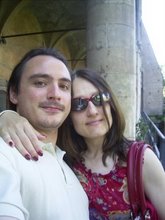In the windows installation on my laptop, I also run a linux server in background. Here is how I setup my virtual linux server.
As a virtualization software I installed Sun VirtualBox. I created a virtual machine. I gave it a little less than the half of my memory and turned on support for AMD-V extensions (as I did also in my host machine BIOS). As HD controller I selected SATA (the default is IDE). For networking I use the NAT configuration. I forwarded the SSH port as described in the virtual box manual (backlinux is the name of my virtual machine):
VBoxManage setextradata "backlinux" "VBoxInternal/Devices/pcnet/0/LUN#0/Config/guestssh/Protocol" TCPThen I followed the suggestion of Sebastian Bauer's blog: I installed the ntwind software's hidden start tool (homepage) and created two one-liner batch files that I use to start and stop the virtual machine. There are also more sofisticated approaches to run the machine as a windows service, however I found this very simple and I chose it for this reason.
VBoxManage setextradata "backlinux" "VBoxInternal/Devices/pcnet/0/LUN#0/Config/guestssh/GuestPort" 22
VBoxManage setextradata "backlinux" "VBoxInternal/Devices/pcnet/0/LUN#0/Config/guestssh/HostPort" 2222
Here is the start.bat file: (paths are specific to my machine)
"c:\Program Files\standalone\hstart\hstart" /NOCONSOLE ""c:\Program Files\Sun\VirtualBox\vboxheadless" -s backlinux -vrdp off"
while the stop.bat file contains:
"c:\Program Files\Sun\VirtualBox\VBoxManage.exe" controlvm backlinux savestate
I created two hard disk images for the machine, called backlinux.vdi and backlinux.home.vdi. I set both to dynamical 8 Gb. I later attached backlinux.home to /home. I keep /home on a separate disk, so that I can make use of the snapshots feature of Virtualbox, without loosing the data in /home. To do this I changed the type of backlinux.home.vdi to write-through using:
"c:\Program Files\Sun\VirtualBox\VBoxManage.exe" modifyhd backlinux.home.vdi --type writethrough
Then I installed ubuntu-server (jaunty, i.e. 9.04) with the option "minimal virtual machine" (press F4 by the installation) and I added some software packages I need/like using aptitude (for example: libncurses-dev, libcairo2-dev, ruby1.9, git-core, gitk ... and relative dependences). The machine has no x-server installed, but I have an X server installed under Windows (Xming), so I can start also graphical software using X-forwarding.
To allow the virtual machine to access the host disk (C:), I installed the VBoxLinuxGuestAdditions from the shell script in the virtual CD image (.iso) provided with virtual box (you need to install linux-headers package for your kernel for that). Then I created a shared folder "c" using the virtual box gui. In Linux then I mounted the folder, creating a /C folder, adding this line to /etc/fstab:
c /C vboxsfAs last step, I created two icons starting from NewTux.svg of Wikimedia Commons (author: Larry Ewing). I resized it to a 48px square and overlayed a green triangle (start icon) and a red square (stop icon). I created then links to my batch files to my desktop and assigned the icons to the links.
Here is the result:



No comments:
Post a Comment